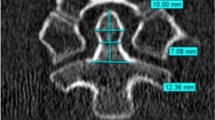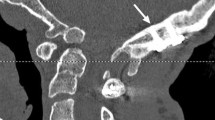Abstract
Purpose
Morphology measures of the odontoid process in children under 12 years old were carried out to demonstrate the viability of anterior internal fixation in this population once their active profile may not be compatible with successful conservative treatment.
Methods
During a 6-month period, 36 tomographic examinations of the cervical spine region that provided visualization of the odontoid process were selected. Group 1 included children between 6 and 9 years of age, and group 2 contained children from 9 to 12 years of age. There were 23 (63.8%) male patients and 13 (36.2%) female patients. Patients diagnosed with a tumor, an infection, fracture non-union, or congenital malformation were excluded. Exams were ordered as part of a protocol applied to non-specific neck pain and pediatric trauma entries. The following parameters were analyzed: (1) screw attack angle, (2) height of the odontoid process, and (3) minimal transverse diameter of the odontoid process.
Results
In Groups 1 and 2, the average values of the screw attack angle were 55.9° ± 2.3° and 54.8° ± 4.5°, respectively; the average heights of the odontoid process were 26.58 ± 3.28 and 29.48 ± 3 mm, respectively, and the average minimal transverse diameter of the odontoid process were 6.57 ± 1.08 and 6.23 ± 0.88 mm, respectively. The minimal transverse diameter of the odontoid process was statistically higher in males than that in females, regardless of age (p = 0.007).
Conclusion
In both groups, the minimal transverse diameter of the odontoid process allowed for the use of one 3.5–4.5 mm screw for anterior internal fixation.
Graphical abstract
These slides can be retrieved under Electronic Supplementary Material.


Similar content being viewed by others
References
Jones TM, Anderson PA, Noonan KJ (2011) Pediatric cervical spine trauma. J Am Acad Orthop Surg 19(10):600–611
Fassett DR, McCall T, Brockmeyer DL (2006) Odontoid synchondrosis fractures in children. Neurosurg Focus 20:E7
Blauth M, Schmidt U, Otte D et al (1996) Fractures of the odontoid process in small children: biomechanical analysis and report of three cases. Eur Spine J 5:63–70
Fulkerson DH, Hwang SW, Patel AJ, Jea A (2012) Open reduction and internal fixation for angulated, unstable odontoid synchondrosis fractures in children: a safe alternative to halo fixation? J Neurosurg Pediatr 9(1):35–41
Tavares JO, Frankovitch KF (2007) Odontoide process fractura in children: delayed diagnosis and successful conservative management with halo cast. J Bone Jt Surg 89:171–176
Henry AD, Bohly J, Grosse A (1999) Fixation of odontoid fractures by an anterior screw. J Bone Jt Surg 81:472–477
Godard J, Hadji M, Raul JS (1997) Odontoid fractures in the child with neurological injury. Direct anterior osteosynthesis with a cortico-spongious screw and literature review. Childs Nerv Syst 13:105–107
Anderson LD, D’Alonzo RT (1974) Fractures of the odontoid process of the axis. J Bone Joint Surg Am 56:1663–1674
Torelli AG, Kohlmann RB, Biraghi OL et al (2012) Tomographic analysis of anatomical parameters of the axis in children. Acta Ortop Bras 20:75–78
Joaquim AF, Patel AA (2015) Surgical treatment of type II odontoid fractures: anterior odontoid screw fixation or posterior cervical instrumented fusion? Neurosurg Focus 38:E11
Jones A, Mehta J, Fagan D et al (2005) Anterior screw fixation for a pediatric odontoid nonunion: a case report. Spine 30:E28–E30
Duransoy YK, Mete M, Unlu UU, Barutcuoglu M, Selcuki M (2013) Synchondrotic fracture of odontoid treat by cervical collar after complication of anterior screwfixation: a case report and review of literature. WScJ 4:25–31
Lustrin ES, Karakas SP, Ortiz AO et al (2003) Pediatric cervical spine: normal anatomy, variants, and trauma. Radiographics 23:539–560
Wang J, Vokshoor A, Kim S, Elton S, Kosnik E, Bartkowiski H (1999) Pediatric atlantoaxial instability: management with screw fixation. Pediatr Neurosurg 30:70–78
Geck MJ, Truumees E, Hawthorne D et al (2014) Feasibility of rigid upper cervical instrumentation in children: tomographic analysis of children aged 2–6. J Spinal Disord Tech 27:E110–E117
Zhao L, Hong J, Wandtke ME et al (2016) An RCT study on the feasibility of anterior transpedicular screw fixation in the cervicothoracic junction. Eur Spine J 25(6):1716–1723
Ji W, Zheng M, Tong J et al (2015) Feasibility and trajectory study of anterior transarticular crossing screw placement for atlantoaxial joint instability: a cadaveric study and description of a novel technique. Eur Spine J 24(12):2954–2960
Eap C, Barresi L, Ohl X et al (2010) Odontoid fractures anterior screw fixation: a continuous series of 36 cases. Orthop Traumatol Surg Res 96:748–752
Feng G, Wendlandt R, Spuck S et al (2012) One-screw fixation provides similar stability to that of two-screw fixation for type II dens fractures. Clin Orthop Relat Res 470:2021–2028
Stulík J, Nesnídal P, Kryl J et al (2013) Unstable injuries to the upper cervical spine in children and adolescents. Acta Chir Orthop Traumatol Cech 80:106–113
Chi YL, Wang XY, Xu HZ et al (2007) Management of odontoid fractures with percutaneous anterior odontoid screw fixation. Eur Spine J 16:1157–1164
Nucci RC, Seigal S, Merola AA et al (1995) Computed tomographic evaluation of the normal adult odontoid. Implications for internal fixation. Spine (Phila Pa 1976) 20:264–270
Daher MT, Daher S, Defino HL (2010) Tomographic evaluation of odontoid parameters related to its internal fixation. Coluna/Columna 9:322–327
Gehweiler D, Wähnert D, Meier N et al (2017) Computational anatomy of the dens axis evaluated by quantitative computed tomography: implications for anterior screw fixation. J Orthop Res 35(10):2154–2163
Tun K, Kaptanoglu E, Cemil B et al (2009) Anatomical study of axis for odontoid screw thickness, length, and angle. Eur Spine J 18:271–275
Khaleel ZL, Besachio DA, Bisson EF et al (2014) Estimation of odontoid process posterior inclination, odontoid height, and pB-C2 line in the adult population. J Neurosurg Spine 20:172–177
Zapałowicz K, Radek M, Radek A (2004) Direct fixation of the odontoid fracture in a child. Neurol Neurochir Pol 38:317–321
Jenkins JD, Coric D, Branch CL Jr (1998) A clinical comparison of one- and two-screw odontoid fixation. J Neurosurg 89:366–370
Funding
This research received no specific grant from any funding agency in the public, commercial, or not-for-profit sectors.
Author information
Authors and Affiliations
Contributions
All authors participated in the writing and review of the manuscript.
Corresponding author
Ethics declarations
Conflict of interest
The authors have no conflicts of interest to declare.
Electronic supplementary material
Below is the link to the electronic supplementary material.
Rights and permissions
About this article
Cite this article
Fernandes, L.G., Cristante, A.F., Marcon, R.M. et al. Feasibility of anterior screw fixation in children: a tomographic study. Eur Spine J 27, 1388–1392 (2018). https://doi.org/10.1007/s00586-018-5504-5
Received:
Accepted:
Published:
Issue Date:
DOI: https://doi.org/10.1007/s00586-018-5504-5




